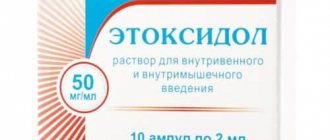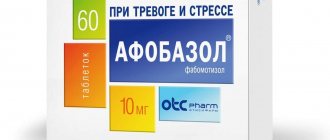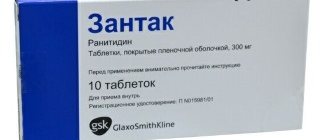Prohibited during pregnancy
Prohibited during breastfeeding
Prohibited for children
Has restrictions for older people
Has limitations for liver problems
Has limitations for kidney problems
The pace of modern life affects people's mental health. Many people experience sleep problems due to frequent stress and anxiety. Due to malfunctions of the nervous system, women experience disruptions in the menstrual cycle and many other disorders occur. It is very difficult to cope with increased nervousness and irritability on your own.
To eliminate unpleasant symptoms, specialists prescribe medications from the group of anxiolytics (tranquilizers). Nozepam is very popular today, which, according to the instructions for use, is effective both for insomnia and for various types of neuroses.
Pharmacodynamics and pharmacokinetics
Pharmacodynamics
A benzodiazepine-type tranquilizer . Has a sedative and anxiolytic effect. It also has muscle relaxant and anticonvulsant activity.
The effect of the drug is associated with an increase in GABA processes in the brain. It has an effect mainly on the retinal activating formation of the brain, reducing the influence of impulses from sensory type receptors on the limbic system and weakening emotional coloring.
Pharmacokinetics
Absorbed relatively slowly, but completely. Reaction with plasma proteins reaches 97%. The maximum concentration is reached on average after 2-3 hours. The drug is able to penetrate the placenta, the blood-brain barrier and be excreted in breast milk. Transformed in the liver to form inactive derivatives. The half-life can range from 5-15 hours. Excreted by the kidneys and through the intestines. Elimination from the body after cessation of therapy is rapid.
Nozepam
Nozepam is a benzodiazepine tranquilizer, one of the psychotropic substances under special control in our country. It has a hypnotic effect, causes sedation, and exhibits an anticonvulsant and muscle relaxant effect. After oral administration, it is absorbed in the gastrointestinal tract for a long time, but in full. Peak concentrations in the blood are achieved within 1 to 4 hours from the moment of administration. It undergoes metabolic transformations in the liver with the formation of pharmacologically inactive derivatives. The half-life varies from 5 to 15 hours. The equilibrium therapeutic concentration is established on days 1-3 of pharmacotherapy. It practically does not accumulate in the body and is quickly eliminated when treatment is stopped. The drug is indicated for neurotic disorders and neurosis-like conditions and accompanying symptoms: increased anxiety, unmotivated irritability and aggression, somnological disorders, severe psycho-emotional stress, depressive symptoms, withdrawal symptoms, menopausal disorders of the emotional sphere. Not used in pediatric practice. The presence of food contents in the gastrointestinal tract does not have a clinically significant effect on the absorption and bioavailability of the drug, which allows it to be taken regardless of diet. The frequency of administration is, according to general recommendations, 2-3 times a day. For withdrawal symptoms - 3-4 times a day. For somnological disorders, which are characterized by insufficient duration or decreased quality of sleep, or a combination of these phenomena, the drug is taken 1 hour before going to bed. For elderly patients, the dose is increased gradually, starting the drug course with the minimum effective therapeutic dosage.
The duration of the course of pharmacotherapy is determined individually and on average does not exceed 1 month. Abrupt discontinuation of the drug is contraindicated. Typical side effects of Nozepam (most of them are characteristic of all benzodiazepine tranquilizers and develop, as a rule, at the beginning of treatment, after which they disappear on their own without any therapeutic intervention): drowsiness, weakness, depression of cognitive functions (attention, slowing of mental reactions), loss of coordination of movements, dizziness, lethargy. Possible hypo- or hypersalivation, a feeling of discomfort or burning behind the sternum, spreading upward from the epigastric region, dyspeptic disorders, skin rash, itching. With prolonged use in submaximal and maximum doses - addiction, pharmacological dependence. If the medication course is abruptly interrupted or the dose is significantly reduced, withdrawal syndrome occurs, manifested by an increase in neurosis-like symptoms. While taking Nozepam, consumption of ethanol-containing products should be avoided. In persons with liver and kidney diseases with a long course of medication, peripheral blood counts and liver enzymes are regularly monitored. In elderly people prone to polypharmacy, a decrease in blood pressure while taking Nozepam can impair cardiac activity. Individuals with a history of active alcohol consumption are at risk of developing pharmacological dependence while taking the drug.
Contraindications
Coma , acute alcohol poisoning, shock, myasthenia gravis , acute poisoning with drugs that suppress the nervous system ( hypnotics, narcotic and psychotropic drugs ), decompensated obstructive chronic pulmonary disease, angle-closure glaucoma , acute pulmonary failure, severe depression , lactation and pregnancy , age less 6 years old, hypersensitivity to the components of the drug.
Indications and contraindications for use
The need to take these tablets is determined by a qualified specialist, having previously conducted an examination and received test results. The main indications are:
- Neuroses.
- Psychovegetative disorders.
- Reactive depression.
- Insomnia.
- Premenstrual syndrome, menopause as a result of menstrual cycle failure.
Reactive depression
Like any drugs, Nozepam may not be suitable for every patient. There is a list of factors in the presence of which taking pills is strictly prohibited. Experts include contraindications:
- individual intolerance to one of the components;
- acute intoxication with alcohol or drugs;
- myasthenia gravis;
- state of shock;
- to whom;
- kidney dysfunction;
- acute lung failure;
- severe forms of depression.
Since the main substance of the drug can penetrate the walls of the placenta and have a negative effect on the development of the fetus, it is not prescribed during pregnancy, regardless of the trimester.
Also, breastfeeding women should not take the tablets, since in pediatrics this drug is prescribed to patients over 6 years of age. If there is an urgent need to undergo a course of treatment, the lactation period must be interrupted.
Side effects
- Reactions from nervous activity: in the initial period of treatment, dizziness, drowsiness, difficulty concentrating, fatigue, ataxia , unsteadiness of gait and impaired coordination of movements, dulling of emotions, lethargy, slowing of mental and motor reactions are possible; more rarely develop euphoria , headache , tremor, depression , depressed mood, memory impairment, stupor, extrapyramidal reactions of dystonic type, muscle weakness, weakness, dysarthria , confusion, paradoxical reactions (for example, psychomotor agitation, aggressive outbursts, fear, muscle spasms , suicidal tendencies, hallucinations , irritability, acute agitation, insomnia , anxiety).
- Hematopoietic reactions: neutropenia, leukopenia, anemia, agranulocytosis, thrombocytopenia.
- Digestive reactions: vomiting, dry mouth, heartburn, drooling, nausea, constipation, anorexia, diarrhea, increased concentrations enzymes , liver dysfunction, jaundice.
- Reactions from the genitourinary system: urinary retention, impaired renal function, increased or decreased libido, urinary incontinence, dysmenorrhea .
- Effect on the fetus: depression of nervous activity, teratogenicity , respiratory failure or inhibition (if the mother of the newborn used Nozepam) of the sucking reflex.
- Allergic reactions: itching , rash.
- Other reactions: drug dependence, addiction, decreased blood pressure, depression of the respiratory center, bulimia , blurred vision, tachycardia , weight loss, anterograde amnesia .
- If the dose is suddenly reduced or the dose is stopped, withdrawal syndrome may occur (headache, dysphoria , irritability, anxiety, agitation, excitement, fear, sleep disturbance, nervousness, spasm of smooth muscles and skeletal muscles, increased sweating, depersonalization, depression , vomiting, nausea, tremor, paresthesia , perceptual disturbances, photophobia, convulsions, tachycardia, acute psychosis , hallucinations).
Possible side effects and overdose
If the treatment regimen was chosen incorrectly or the patient has hypersensitivity to the components of the drug, the side effects listed in the table may occur.
| System | Negative consequences |
| CNS | Drowsiness, dizziness, ataxia, tremor, depression, impaired coordination of movements, tremor, headache. |
| Hematopoietic system | Anemia, thrombocytopenia, neutropenia, agranulocytosis, leukopenia |
| Digestive system | Dry mouth, increased salivation, heartburn, constipation, nausea, vomiting, diarrhea, stomach dysfunction. |
| Genitourinary system | Dysmenorrhea, urinary retention, kidney dysfunction, weakened libido. |
If you are allergic to the drug, rashes on the skin are observed. The list of side effects also includes bulimia, addiction, dependence, tachycardia, weight loss, low blood pressure and anterograde amnesia.
If the patient takes pills for a long period of time or a single dose greatly exceeds the permissible amount of medication, signs of overdose may appear.
This condition is accompanied by loss of consciousness, drowsiness, and slurred speech. In some cases, a person may fall into a coma.
First aid methods include gastric lavage and taking activated carbon (1 tablet per 10 kg of weight). It is also necessary to report any deterioration in condition to your doctor. The overdose condition requires symptomatic therapy.
Instructions for use of Nozepam (Method and dosage)
Instructions for use of Nozepam recommend taking the drug orally with water. Choose the smallest effective dosage and short duration of therapy if possible.
For neurotic conditions complicated by increased irritability, agitation, fear, anxiety, adults are prescribed a single dose of 10-30 mg. In the case of outpatient treatment, the usual daily dose is usually 20-30 mg, divided into 2-3 doses. In severe cases, the dosage is increased to 15 mg in the first two doses and to 15-30 mg in the evening. The highest daily dose is 120 mg. Doses over 60 mg are prescribed only if hospital treatment is possible.
For sleep disorders (insomnia) caused by anxiety, 10-25 mg of Nozepam is recommended an hour before bedtime. The largest single dose in this case is 50 mg. In the evening, the drug should not be taken directly after a meal, as its effect slows down and, depending on the duration of sleep, residual reactions may occur (fatigue, impaired concentration the next morning).
When treating alcohol withdrawal syndrome, take 15-30 mg of Nozepam 3-4 times a day. In elderly or weakened patients, with insufficiency of the liver, kidneys, heart or lungs, as well as with organic brain damage, a daily dose of 10 mg is set, divided into two doses; if necessary, it is increased to 15 mg per day.
14 days after the start of therapy, you should ensure that there are indications for continuing use of the drug, since it is undesirable to exceed the duration of continuous treatment of 4 weeks. Taking beyond this period may cause mental and physical dependence on the drug. If long-term treatment is necessary, stop taking the medication for several days, and then return to its use at an individually selected therapeutic dose.
The use of the drug is stopped slowly, gradually reducing the dose. Abrupt cessation of taking Nozepam can provoke withdrawal symptoms: anxiety, agitation, sleep disturbance.
General information about the drug
Nozepam is a benzodiazepine anxiolytic.
It is characterized by anxiolytic and sedative properties. Has a positive effect on the central nervous system (CNS), calms and relaxes. The drug also has slightly pronounced muscle relaxant effects and anticonvulsant activity. In addition, it is often prescribed for withdrawal symptoms in people suffering from alcohol or drug addiction. Before taking it, you should consult a doctor and read the instructions. Since this drug is a tranquilizer, if taken for a long time, it can cause addiction or withdrawal syndrome (with abrupt cessation of use).
Drug group, INN, scope of application
Nozepam belongs to the group of anxiolytic medications. It is a narcotic psychotropic drug and therefore subject to control. You can purchase the medicine only with a prescription from a doctor. MNN: Oxazepam.
Prescribed for sleep disorders, phobias, fears and anxiety. You can take the medicine with the permission of a specialist if there is a clearly expressed need.
Self-medication with these drugs is dangerous to health.
Forms of release and, average in Russia, prices for the drug
The medication is available in tablet form. Tablets are packaged in blisters (10 pieces) or in a glass jar (50 pieces). The tablets come with detailed instructions for use.
Since this medicine is a psychotropic narcotic drug, it is not freely available. You can check the price and availability in pharmacies in your city. The cost ranges from 82 to 315 rubles, depending on the manufacturing company.
Overdose
In case of an overdose of oxazepam, the following symptoms may appear: a state of disorientation, drowsiness, loss of consciousness, slurred speech, coma . Particularly life-threatening are poisonings caused by the combined use of alcohol and oxazepam , or other drugs that suppress nervous activity and oxazepam .
In case of overdose, actions are taken aimed at eliminating the drug from the body or reducing its absorption in the digestive system (gastric lavage, administration of Activated Carbon ), they also monitor vital functions (pulse, respiration, blood pressure) and, if necessary, carry out symptomatic treatment.
Flumazenil is a specific antidote for oxazepam .
When treating an intentional overdose, it must be remembered that the patient could take several different drugs at the same time.
Interaction
When used together with oral contraceptives , the effectiveness of Nozepam decreases.
When used simultaneously with Zidovudine, bioavailability increases and the frequency of headaches increases.
When used together with Phenytoin, there is a risk of reducing the level of oxazepam in the blood.
When used together with ethanol, its inhibitory effect on the nervous system increases.
special instructions
The medicine should be used with caution if there is a tendency to hypotension , an increased risk of drug dependence, insufficiency of liver or kidney function, in the elderly, with ataxia of the spinal and cerebral type, a tendency to abuse psychotropic drugs, hyperkinesis , organic diseases of the brain, hypoproteinemia, psychosis , night apnea.
Oxazepam is not recommended for long-term use due to the possibility of drug dependence.
With long-term treatment, it is necessary to monitor blood counts and liver function.
Any change in dosage should be made under the supervision of a physician.
During treatment with the drug, it is prohibited to drive vehicles.
Interaction with other drugs and special instructions
The simultaneous use of medications from the same or different pharmacotherapeutic groups can be life-threatening. If a person is taking any medications, he must inform the doctor at the first consultation.
Features of drug interactions:
- Oral contraceptives have a negative impact on the effectiveness of the drug.
- Phenytoin reduces the concentration of the active substance Nozepam in the blood.
Phenytoin - Zidovudine increases the percentage of bioavailability, which leads to an increase in the occurrence of headache attacks.
- Sleeping pills, narcotic analgesics, antiepileptic drugs in combination with Nozepam enhance each other’s effects, increasing the risk of overdose and drug dependence.
- In combination with clozapine, respiratory depression increases.
Treatment with this drug has a number of features that must be taken into account before use:
- It is strictly forbidden to take pills and drink alcohol;
- exceeding the dose leads to the development of physiological and psychological dependence;
- in the presence of renal/liver failure during treatment, it is necessary to keep the picture of “liver” enzymes and peripheral blood under control;
Normal liver enzyme levels - Only a qualified specialist can adjust the dosage or extend the course of therapy.
This medication affects the ability to drive. Therefore, it is advisable not to drive immediately after taking the pill. It is also advisable to refrain for a while from work that requires maximum concentration.
Analogs
Level 4 ATC code matches:
Bromazepam
Helex
Rudotel
Relium
Tazepam
Xanax
Elenium
Valium Roche
Alprazolam
Tofisopam
Diazepam
Grandaxin
Mezapam
Sibazon
Seduxen
Relanium
Lorazepam
Analogues of Nozepam: Tazepam, Grandaxin, Oxazepam, Relanium, Sibazon, Oxazepam-Ferein, Phenazepam, Diazepam, Elenium.
During pregnancy and lactation
Nozepam has a toxic effect on the fetus and increases the risk of congenital malformations when used in the first trimester of pregnancy. The use of therapeutic dosages at a later date may cause suppression of the nervous activity of the newborn. Systematic use during pregnancy can provoke physical dependence with the appearance of withdrawal syndrome in the newborn.
Use immediately before or during childbirth causes decreased muscle tone, respiratory depression, hypothermia , hypotension and suppresses the sucking reflex in the newborn. The drug is contraindicated during breastfeeding.








